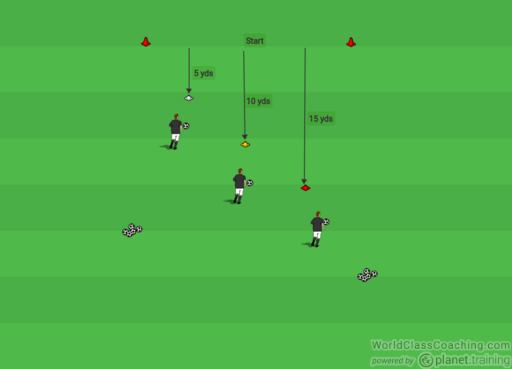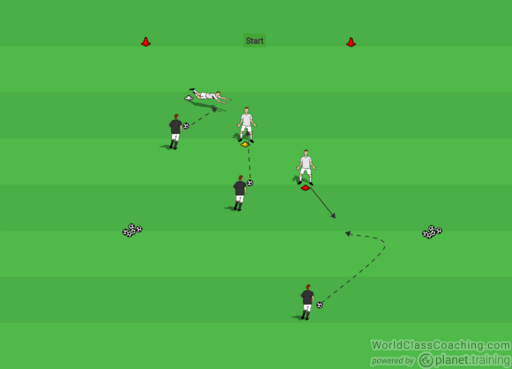By Scott Housden -
A goalkeepers’ ability to recover once they have gone to ground is a paramount skill in order to be able to make second or even third phase saves. This drill has elements of specific conditioning for this purpose but also focuses on a goalkeepers’ technique remaining strong once they start to fatigue.
Set Up
The set up as shown in the diagram below requires cones and balls with ideally 3 servers. However, this drill can be performed in pairs with the server moving on to the next station as the goalkeeper is recovering back to the start line.
- The server for the first station is set approximately 3-4 yards away from the cone.
- The server for the second station is set approximately 5-6 yards away from the cone.
- The server for the third station is set approximately 10 yards away from the cone.
- The goalkeeper takes up a position on the start line

The drill starts by the goalkeeper sprinting to the first cone (which is 5 yards away) and getting into their ‘set’ position.
The server immediately throws a ball between knee and waist height to the goalkeeper’s left hand side for the goalkeeper to make a ‘foot, knee shoulder’ diving save. The goalkeeper returns the ball to the server whilst they are on the ground and then recover back to their ‘set’ position ready to make a save to their right hand side.
At the first station the goalkeeper makes 8 diving saves (4 to their left and 4 to their right).
Once the first station is completed the goalkeeper must sprint back to the start line and sprint to the second station (10 yards away).

Here the goalkeeper starts on their knees (or seated on the ground). From this position they must recover to their ‘set’ position as quickly as possible.
As soon as the goalkeeper is ‘set’, the server then volleys a ball to the goalkeepers’ chest height for the goalkeeper to catch and return before they sit or kneel back down to repeat a further 7 times (8 in total).
Once the first station is completed the goalkeeper must sprint back to the start line and sprint to the third station (10 yards away).
At the final station the goalkeeper must start lying face down in a ‘skydive’ position (i.e. hand and feet not touching the ground).
The goalkeeper must then recover to a standing position as quickly as possible. As soon as this happens the server throws a high ball for the goalkeeper to move to and collect at the highest possible point (simulating dealing with a cross).
The goalkeeper then returns the ball to the server before returning to the cone at the third station and repeating a further 7 times (8 in total).
Once they have completed the third station the goalkeeper must then sprint back to the start line.
Coaching Points
• Focus on a strong ‘set’ position with relaxed shoulders and ‘active’ hands for every repetition, especially when the goalkeeper starts to fatigue.
• This is the same for their ‘foot, knee, shoulder’ diving technique. It is essential that they lead with their hands and take that angled step towards the path of the ball on each occasion.
• Try to encourage the goalkeeper to use either the ‘pendulum’ or salmon technique when recovering from a diving save. This allows the goalkeeper to generate and use their own body momentum for the recovery. This is the most energy efficient method for recovery form diving saves.
• Encourage the goalkeeper to remain focused throughout the duration of each of the three stations, including the sprints to and from each station.
• The seated or kneeling start position is not a common position that a goalkeeper will find themselves in. However, encourage the goalkeeper to think of and use the fastest recovery method into a strong ‘set’ position.
• It is essential that when the goalkeeper is dealing with the high balls at the third station that they focus on taking the shortest possible route to the ball using quick short steps, thrusting one knee up and catching the ball at the highest possible point.
Progression
The number of serves per station can be increased to 10 per station or 10 at the first station, 12 at the second station and 14 at the third station.
The goalkeepers must keep facing the server when moving back to the start line in between stations.
For younger goalkeepers the number of repetitions can of course be reduced.
By Scott Housden
Scott is both a UEFA ‘B’ and UEFA ‘B’ Goalkeeping Coach and holds a Masters in Sports Management. He has been a goalkeeper coach in professional football in the UK and Australia at First Team, Academy and Women’s levels. He currently runs a Goalkeeper Academy in the Western Suburbs of Brisbane, Australia.


